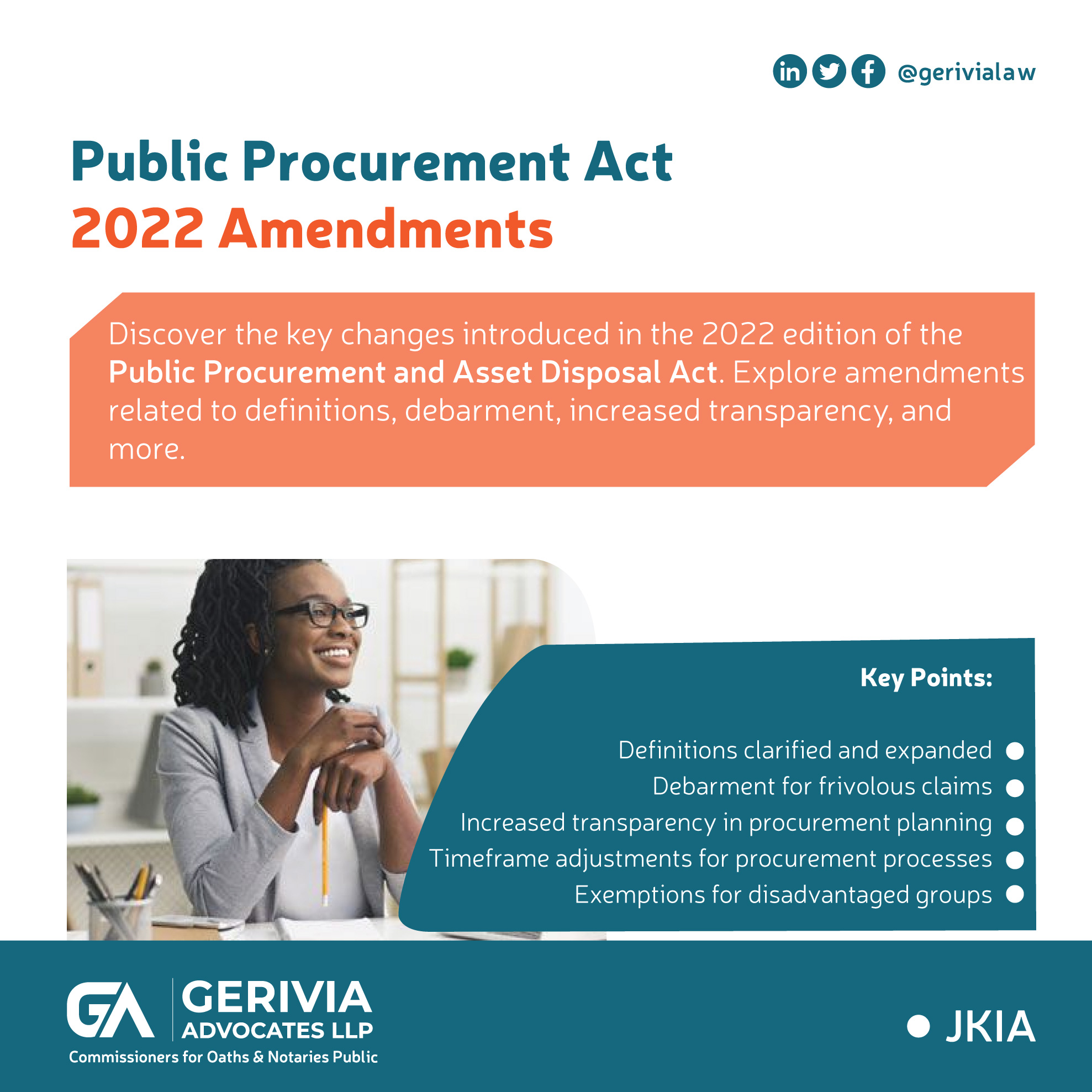Introduction
On 28th September 2020, Gerivia Advocates LLP, amongst other law firms and organisations, were invited to Parliament by the Departmental Committee on Transport, Public Works and Housing, which is Chaired by Honourable David Losiakou Pkosing, to make submissions on the National Aviation Management Bill, 2020 (hereinafter the Bill).
This invitation emanated from the submission to Parliament of feedback on the Bill following a review by the firm. Aviation Law being one of the niche practice areas for Gerivia Advocates LLP, the firm would not have missed the opportunity to review the Bill and provide feedback to the relevant Parliamentary Committee.
The paper submitted to the Committee contained more detailed recommendations, including a section by section review and feedback on the Bill. This summary seeks to highlight the major concerns with the National Aviation Management Bill, 2020 and some of the solutions we propose.
Some of the proposed solutions are not new ideas or purely our own, but they echo some of the proposed solutions already captured in the report of the Departmental Committee on Transport, Public Works and Housing dated 17th June 2019 (“the Pkosing Report”).
The Bill has elicited mixed reactions, mostly apprehension, and with good reason. Our beloved national carrier, Kenya Airways (KQ), has been posting troubling results for a couple of years now. The future of KQ is therefore an issue of concern not just to the country’s leadership but to any patriotic Kenyan.
The proposed solution of nationalizing the national carrier means that public money, and colossal amounts of it, will be invested in efforts to revive KQ and bring it back to profitability. Questions abound, including whether nationalization is a feasible solution, noting that this has not resolved the challenges of other national carriers.
World over, flag carriers have been struggling with profitability especially with the advent of budget airlines and other challenges facing the aviation industry including the recent outbreak of the COVID-19 Pandemic. With many flag carriers ending up in bankruptcy, the future of flag carriers remains in doubt.
The general trend or feeling in the country is that levels of accountability where public money is involved are wanting. Such money is handled in a lackadaisical manner, with that underlying notion that this is “mali ya umma” and there is always more where it came from.
So, if KQ could not thrive under the private sector which is more profit driven and has higher demands on accountability on the use of investors’ money, will it fair better as a State Entity which enjoys exemptions from national laws that increase probity and accountability, if the Bill is to be approved as is?
Background of the Bill
The Bill comes against the backdrop of the rejection by Parliament of the Privately Initiated Investment Proposal (PIIP) by KQ which (in a nutshell) sought to have KQ take over the operations of the Kenya Airports Authority (KAA).
It is argued that the PIIP was rejected with good reason since the handing over of a state entity and its valuable public assets to a loss-making private entity owned largely by private individuals/shareholders would have amounted to enriching private individuals using state resources and would be outright plunder.
It is reasonable that if colossal amounts of public funds are to be invested towards the rescue of KQ, then it might as well be converted to a state entity.
There is a school of thought that argues that most national airlines are rarely profitable entities and that their benefits should not only be viewed through the narrow lenses of profitability but rather in appreciation of the other numerous benefits that they bring to a country. These other benefits include opening up the country to the world by bringing in visitors, marketing the country abroad and promotion of national pride and sovereignty.
While these other benefits may not be easy to quantify in monetary terms, it is clear that promotion of tourism and investment, easy movement of cargo in and out and marketing the country abroad definitely have quantifiable economic value to the country.
Against this background and noting that KQ has struggled with profitability as a private company, then a discussion and even a Bill is a welcome attempt to rescue our national carrier.
The main question remains, is the proposed rescue Bill fit for purpose?
An Analysis of the Bill
Short Title of the Bill
The short title of the Bill states that it is, “AN ACT of Parliament to provide for the establishment of the National Aviation Council, Kenya Aviation Corporation and its Operating Entities; to provide for their powers, functions and management and for connected purposes.”
This short title is a good place to start this review. The simple title should have been, “An Act of Parliament to Nationalize Kenya Airways and for connected purposes” or “An Act of Parliament to establish Kenya Airways as a State Entity and for connected purposes.”
Rather than focus on the raison d’être of the Bill, which is how to rescue our beloved and troubled KQ, the Bill went on to drag other entities into the already sensitive rescue effort and to create a “super aviation structure” with multiple levels of bureaucracy. The rescue of KQ is already a very delicate experiment, even without roping in other aviation players.
It is unclear why the proposed solutions for KQ seem to be inextricably intertwined with KAA and other aviation entities – which are not in the same dire financial straits as KQ – with the risk that should such solution not work, we will end up with multiple failing entities instead of one.
The Proposed Structure in the Bill
Inclusion of the President in the National Civil Aviation Council
Section 5(1) of the Bill proposes formation of the National Civil Aviation Council which shall comprise the President as one of its members.
It is proposed that the President of the Republic should not serve in the National Civil Aviation Council. The reasoning here is that this Council is expected to handle issues specific to one sector. This in our view limits the view of the presidency which is expected to be broad, national and integrative.
The decisions of this Council may be subject to examination, scrutiny or questioning by the Parliament. This raises the question whether the president would then be summoned to answer to a Committee of the Parliament. This could lead to an awkward/embarrassing legal dilemma.
Inclusion of the President in the Council should have a clear benefit and/or weight that his participation brings in. In the present case, this is not apparent. This country has operated the aviation industry for over half a decade. There is adequate expertise to run the sector.
The presidency has never been involved in the running of the sector and we are certain with good organization, the President will be of more use guiding policy at cabinet level as is the case today.
Proposed Aviation Management Structure
The Bill proposes formation of what we consider to be an overly bureaucratic aviation management structure. Noting the challenges at hand and the need for a speedy solution, a simpler and more nimble structure would have been more ideal.
The Bill at section 6 proposes establishment of Kenya Aviation Corporation (KAC) which will hold assets and oversee the operations of the Operating Entities (OEs). The OEs are:
-
Kenya Airways – established as an entity under section 23 of the Bill
-
Kenya Airports Authority – established as an authority under section 26 of the Bill, as the successor to the former Kenya Airports Authority
-
Aviation Investment Corporation – established as an entity under section 29 of the Bill
The entities above are to be entered by the Registrar of Companies into the Register of Companies and issued with a Certificate of Registration (sections 23 (3), 26 (4) and 29 (3)), with the status of a state owned entity established under this Act i.e. this Bill.
It should be highlighted at this stage that even though the Bill envisages registration of these entities under the Companies Act as state owned entities, the Bill indicates at section 10L that none of the other provisions of the Companies Act shall apply to these entities.
KAC will mainly steer the Government agenda/strategy with regard to the aviation sector (section 9). The most important agenda however is that it controls the assets of the group. This means that all the monies collected by any of the OEs will be administered by KAC.
Each of the OEs will have a leadership structure including a board of management and management personnel in each case led by a Managing Director. The following risks arise with the creation of this “aviation super structure”:
- There is a risk of excessive bureaucracy in decision implementation due to the complex and burdensome leadership structure in the sector.
- Each OE is allowed to have subsidiaries operating under it. Each subsidiary may have a director who is appointed by the KAC Board (the Board) upon nomination by the by the CEO of KAC.
- There is lack of clarity as to whether this person(s) is nominated upon interviews by the MD of the OE or it is directly nominated by the CEO of KAC.
- The director will however be reporting directly to the MD of the OE despite the fact that he is not the appointing entity.
- On bureaucracy, it is clear that the MD of the OE does not have the final word on most issues – issues will have to be escalated to the Board through the CEO. It therefore means that the director of the subsidiary has to escalate the issue to the MD of the OE, who will then escalate it to the CEO of KAC.
- The CEO of KAC might find it necessary to escalate the issue to the Board and if the Board raises any issues that require clarification, noting that subsidiary entities’ directors do not sit in the Board, it will require a corresponding process in reverse to seek such clarification.
It is our considered view that the structure could be complicated and expensive to run and even to evaluate performance.
The fact that the entity which collects the revenue will not necessarily get the priority in allocation of funds, and that the entity that gets the lion share of allocation might not bring corresponding returns negates the natural and simple principle that “hard work only pays off when it meets the right plan of action”.
We again bring up the fact that governance is undertaken by natural persons. In this case, KQ has a lot of liabilities. There is no guarantee that the Bill, if passed will make the liabilities go away or indeed bring about recovery of the airline.
What is clear, however, is the fact that equitable sharing of the Fund means that the money available from Air Passenger Service Charge (APSC) might end up covering the liabilities of the airline. What then will be the motivation of the KAA team to work hard on the sector strategy they have been allocated?
Tying up of all the aviation sector players together, in our view, is not good practice and in the long run, we could have a wholesome collapse of the industry if one Operating Entity mismanages the finances.
We note that the Board will be in a position to mobilize finances across the Group. The risk exposure of the Group is rather high as the misfortunes of one OE affects the entire Group, as opposed to the current situation where faltering by one member cannot incapacitate the industry.
Other Notable Provisions in the Bill
Indication of Share Capital to Some Entities under the Bill
Section 25 of the Bill indicates that the initial share capital of KQ shall be seven billion four hundred and eighty two million three hundred and forty-five thousand, one hundred and seventy four (7, 482, 345, 174) shillings divided into 74, 823, 452 ordinary shares, meaning that each share is valued at KES. 100/=.
Section 28 of the Bill indicates that the initial share capital of KAA shall be sixty-six billion (66, 000, 000, 000) shillings divided into sixty-six million (66, 000, 000) ordinary shares. Each share is therefore valued at KES. 100/=.
Section 31 of the Bill states that the initial share capital of Aviation Investment Corporation is One Million (1, 000, 000) shillings divided into fifty thousand (50, 000) ordinary shares.
Noting that the Bill seeks to nationalize KQ and KAA is not being privatized, the decision to assign an initial share capital to these OEs in the Bill raises some concerns.
Was the valuation of the share capital for these entities preceded by a feasibility study and proper valuation exercise? Is the share capital an indication of preparations in case of future privatization plans or what was the wisdom (or lack of it) in adding this share capital aspect to these operating (state) entities?
Written by George Karuthui Kamau, Susan Wairimu Munene & Sylvia Wambui Waiganjo




